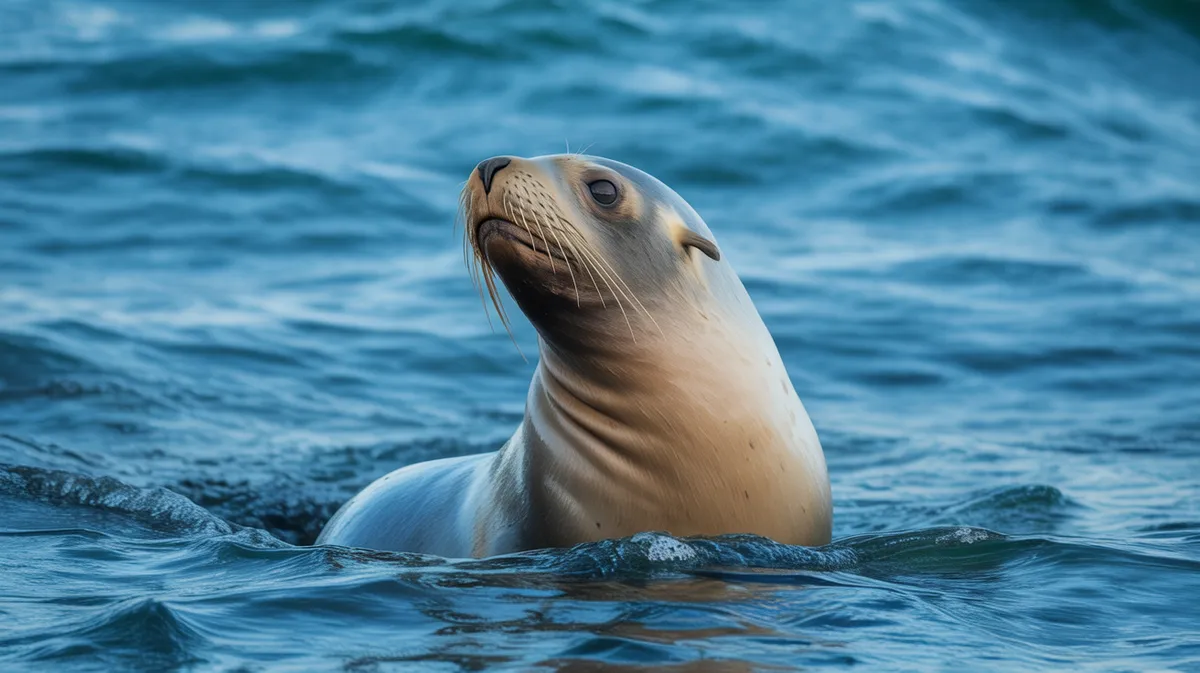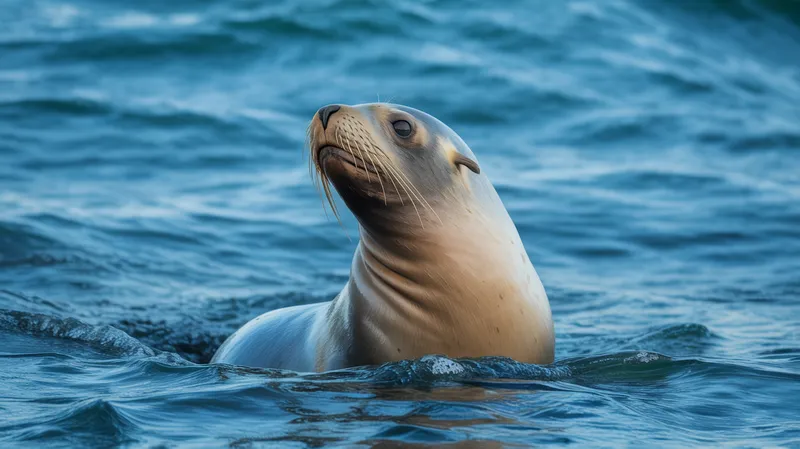
Australian Sea Lion
Neophoca cinerea

Meet the Australian Sea Lion
The Australian Sea Lion is a rare and charismatic marine mammal native to the southern and western coasts of Australia. It has a robust body, short fur, and is easily identified by its creamy to yellowish coloring on the face and underparts, contrasted with a dark brown back. Known for their playful behavior, Australian Sea Lions are also strong swimmers, often seen surfing waves close to shore. Their breeding colonies are found on isolated sandy beaches and rocky coasts, and they have a very unusual 17-18 month breeding cycle, one of the longest among pinnipeds.
Classification
Mammal
Habitat
Coastal waters and islands
Diet
Carnivore
Lifespan
15-25 years
Conservation
Endangered
Weight
70-300 kg
📖Fascinating Facts
Unique Breeding Cycle
The Australian Sea Lion has a distinctive breeding cycle lasting about 17-18 months, which is not synchronized across colonies, making population management complex.
Vocal Communicators
Mothers and pups recognize each other through unique vocalizations, which is critical for survival in crowded colonies.
Diving Experts
They are skilled divers, able to reach depths of over 100 meters and remain underwater for up to 8 minutes while hunting fish, squid, and crustaceans.
📋Detailed Description
The Australian sea lion (Neophoca cinerea) is a medium-sized otariid pinniped distinguished by marked sexual dimorphism: adult males reach lengths of 200–250 cm and weigh 200–300 kg, while females are smaller, measuring 130–180 cm and weighing 60–110 kg. Males exhibit a striking dark chocolate-brown coat with a contrasting creamy yellow mane and nape, whereas females are silver-grey to fawn with a pale underbelly. Their streamlined, fusiform bodies and strong foreflippers enable agile swimming and deep diving, often exceeding depths of 80–120 meters and lasting up to 8 minutes per dive. Australian sea lions are highly social, forming breeding colonies on isolated sandy beaches and rocky outcrops along the southern and western Australian coasts. Their vocal repertoire is complex, including barks, growls, and mother-pup contact calls. They are opportunistic predators, feeding primarily on benthic fish, cephalopods, and crustaceans, and are known to employ cooperative hunting strategies. The species is notable for its unique, aseasonal 17–18 month breeding cycle, with asynchronous pupping across colonies. Pups are born with a chocolate-brown lanugo coat, which is shed after several months. The species exhibits strong site fidelity, with both sexes returning to natal colonies to breed. Longevity in the wild is estimated at 17–25 years, though survival rates are impacted by environmental and anthropogenic pressures.
💡 Did you know?
Unlike most seals and sea lions, Australian Sea Lions do not have a fixed annual breeding season—each colony breeds on its own unique schedule.
🔬Research & Sources
Wikipedia Summary
The Australian sea lion, also known as the Australian sea-lion or Australian sealion, is a species of sea lion that is the only endemic pinniped in Australia. It is currently monotypic in the genus Neophoca, with the extinct Pleistocene New Zealand sea lion Neophoca palatina the only known congener. With a population estimated at 14,730 animals, the Wildlife Conservation Act of Western Australia (1950) has listed them as "in need of special protection". Their conservation status is listed as endangered. These pinnipeds are specifically known for their abnormal breeding cycles, which are varied between a 5-month breeding cycle and a 17-18 month aseasonal breeding cycle, compared to other pinnipeds, which fit into a 12-month reproductive cycle. Females are either silver or fawn with a cream underbelly, and males are dark brown with a yellow mane and are bigger than the females.
Last Modified: 4/24/2025
🎭Behavior & Social Structure
Australian sea lions are diurnal and spend significant time hauled out on land for resting, socializing, and thermoregulation. At sea, they are solitary or form small foraging groups, utilizing their sensitive vibrissae to detect prey on the seafloor. Their foraging trips are typically within 40 km of breeding sites, with females making shorter, more frequent trips to provision pups. Social interactions are complex, especially during the breeding season, when dominant males establish and defend territories containing harems of up to 10 females. Agonistic displays, including chest-to-chest posturing and vocalizations, are common among males. Pups engage in play behavior, which is thought to aid in the development of social and hunting skills. Resting periods on land are punctuated by bouts of grooming and social bonding.
👶Reproduction & Life Cycle
Breeding occurs asynchronously, with each colony exhibiting its own pupping interval of 17–18 months, a rare phenomenon among pinnipeds. Males arrive at colonies before females and compete for territories. Females give birth to a single pup after a gestation period of approximately 14–18 months, which includes a delayed implantation phase of 3–4 months. Pups are nursed for 15–18 months, one of the longest lactation periods among otariids, and maternal attendance patterns are characterized by alternating periods of foraging at sea and nursing ashore. Females exhibit strong natal philopatry, returning to their birth colony to breed. Sexual maturity is reached at 4–6 years for females and 8–9 years for males.
🛡️Adaptations & Survival
Australian sea lions possess several adaptations for their benthic foraging lifestyle, including large, forward-facing eyes for low-light vision, highly sensitive vibrissae for detecting prey in sediment, and robust forelimbs for maneuvering in complex underwater habitats. Their thick blubber layer provides insulation in cold southern waters, while their unique breeding cycle may reduce interspecific competition for resources. Social and vocal communication is highly developed, facilitating mother-pup recognition and territory defense. Their ability to undertake extended, deep dives allows access to prey unavailable to many sympatric predators.
📚Research Sources
🎨Cultural Significance
Australian sea lions have been historically significant to Indigenous coastal communities, featuring in local lore and as a traditional food source. In contemporary Australia, they are emblematic of marine conservation efforts and ecotourism, particularly at sites like Seal Bay Conservation Park. Their charismatic presence attracts visitors and supports local economies, while also serving as a flagship species for broader marine ecosystem protection.
🔬Recent Research & Discoveries
Recent research has focused on the species' unique reproductive biology, foraging ecology using satellite telemetry and stable isotope analysis, and the impacts of fisheries bycatch. Genetic studies have revealed low gene flow between colonies, highlighting the importance of managing populations at the colony level. Ongoing studies are investigating the effects of climate variability on pup survival and the efficacy of exclusion devices in reducing bycatch. The Australian sea lion is also a model for understanding pinniped adaptation to benthic foraging and asynchronous breeding.
🎥Wildlife Videos

The Sea Lion King - An Epic Adventure | Free Documentary History
The Sea Lion King - An Epic Adventure | Ocean Documentary Watch 'Adventure Ocean Quest - Unveiling the Secrets of the ...
Free Documentary - Nature

A Sea Lion Goes For a Walk | Secrets of the Zoo: Down Under
An 11 year old Australian Sea Lion goes for a walk through the marine area of the Taronga Zoo, and visits the penguins while he's ...
Nat Geo Animals

Sea Lion's Wild Nature National Geographic Documentary 2021HD 4K
Just be happy and Enjoy... Please Click subscribe for more videos... Love Animal - If you also love animals like me please ...
Animals and Insect TV

Australian Sea Lions Guardians of the Coast ! Animal Tales
Join us on Animal Tales as we dive into the fascinating world of the Australian sea lions, the true guardians of the southern coasts.
Animal Tales

Sea Lion's First Fighting Lesson | New Kids In The Wild 202
Watch sea lion Lola take her first chaotic steps into a macho battlefield on Argentina's coast. Cheer as this baby learns key vocal ...
Love Nature

The Marvelous World of Sea Lions | Wildlife Documentary | Fusion Documentary
Explore the marvelous world of sea lions in this wildlife documentary. Learn about these fascinating creatures and their unique ...
Fusion Documentary
🌍Habitat Information
The Australian Sea Lion typically inhabits Coastal waters and islands environments. Australian Sea Lions have adapted to their environments with specialized features and behaviors.
Primary Habitat:
Coastal waters and islands
More detailed habitat information will be available soon.
🛡️Conservation Status
The Australian Sea Lion is currently classified as Endangered. Conservation efforts are crucial for preserving this species for future generations.
Common Threats:
- 🏠Habitat loss and fragmentation
- 🌡️Climate change impacts
- 🎯Hunting and poaching
- 🏭Human-wildlife conflict
⚠️Threats & Conservation Challenges
The primary threats to Australian sea lions include bycatch mortality in commercial gillnet and trap fisheries, entanglement in marine debris, habitat disturbance from tourism and coastal development, disease outbreaks (notably hookworm infection in pups), and predation by sharks. Population fragmentation and low reproductive rates exacerbate vulnerability, with some colonies exhibiting ongoing declines. Climate change poses emerging risks through altered prey availability and increased storm frequency impacting breeding habitats. Conservation challenges include enforcing fishery bycatch mitigation, managing human disturbance, and enhancing monitoring of small, isolated colonies.
🔬Scientific Classification
Scientific Name
Neophoca cinerea
Classification Hierarchy
🔍 About Taxonomic Classification
Taxonomic classification is a hierarchical system used by scientists to classify and organize living organisms based on shared characteristics and evolutionary relationships.
The system moves from broad categories (Kingdom) to increasingly specific ones, with each animal's scientific name typically consisting of its Genus and species.
📝Community Notes
Share your observations and insights about the Australian Sea Lion with our community of wildlife enthusiasts.
Join Our Community
Sign in to share your observations and connect with fellow wildlife enthusiasts.
Sign In to ContributeNo community notes yet
Be the first to share your observations about the Australian Sea Lion!
Explore Australian Sea Lion
Select a tab above to learn more about this amazing animal.
📸Photo Gallery
No photos available for this animal yet.
🌟Discover More Wildlife
Continue your journey of discovery with more fascinating animals from our database
